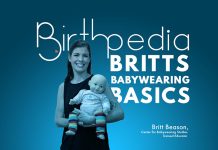Why Fidella Fly Tai is the best for babywearing?
[TRANSCRIPT OF ANSWER]
“Hey, it’s Brett Beason, your babywearing coach here with Birthpedia. Today we’re going to do a full tutorial of the Fidella Fly Tai in a newborn size. Let’s go. Here’s our Fidella Fly Tai. This is an extremely adjustable carrier. The company says that it’s good for newborns as small as 56 centimeters tall, which translates to about 22 inches tall.
Today we’ve got a great opportunity to use a real baby to show you how this thing really looks and try to get the field straight across to you with a real human. You’re probably going to hear him cooing down here while I’m telling you all about it.
So when you first receive your Fidella Fly Tai and take it out of the packaging, you’re going to notice that it’s in the widest and tallest setting. If you’re using this carrier for your newborn, you’re going to need to make that a lot smaller. So I’m going to use my doll and put this carrier on the floor and show you how we do that. Ready?
How to start with the setup?
So if you’ll notice I’ve laid the carrier out with the ties facing up, we’re going to cinch these down to accommodate for the size that our baby is now. So I’m going to put the baby right in the middle of the carrier with their shoulders equal to the top of the carrier.
I’m going to position babies’ knees apart so that I can correctly judge how the carrier should fit. So first I want to shrink the carrier up to be the proper height for this baby. And we will do that by cinching. These pieces down until the carrier come just underneath the baby’s legs. As you can see here. Then we can secure each of these by completing the knot.
Tighten up the initial adjustments according to baby size
Next, we’ll move to between the legs. We need to make the seat to where it only goes from knee to knee and it will not force the legs out. So we’re going to find that drawstring and cinch that in and we can wrap this up and see now that it’s going to go very nicely. Edge to edge on the seat there knee to knee on the baby so I can go ahead and tie that off there.
So the last adjustment we need to make is actually underneath baby. I want to bring this in so that it’s only about the width of the baby’s shoulders. So I need to move the baby off of the carrier to be able to access that drawstring and I’m just going to tighten it up a little bit to accommodate that measurement I just made. And then to just test everything out, I can put baby back that comes just to the outside of the shoulders. And this comes just to the underside of the legs. This should be sized perfectly for this newborn baby.
Setting up Fidella Fly Tai on caregiver’s Body
Now we’re ready to put the carrier on the caregiver’s body so we can put the baby in it.
All right, here we go. So the waistband of the fidella fly tai is to be applied directly at your waist so that the carrier folds back out over it and it just passes right around behind you and you’re going to tie twice for a nice secure knot.
We never want to put the carrier too low. We need to make sure the baby is nice and high and close enough to kiss. And we know that the baby is only about this tall. So that’s where I want his bottom to be. So that’s where I’m going to place the top of the waistband on the carrier.
So before I pick up the baby, I’m going to take just a moment and pull these straps out in front of me and kind of get them organized. So before we actually get the baby, we’re going to take one side and put it over the shoulder that it came from. It doesn’t matter which side you choose, just pick a side over your shoulder so you can start to see where the baby’s going to sit here. And then with the opposite hand, bring it around because this is where it’s going to come.
So hot little tip. Do yourself a favor, take this piece and just stick it right underneath your waistband so it’s ready for you when you need it. And you can just pull this out and it’ll be where you want it to be without you having to fiddle with it and it also goes ahead and gets that piece off the ground. So there’s that nice little tip for you.
Place your baby carefully above the waist
All right, so we’re ready for our baby to slide in through here. Now you’re going to pick up your baby. All right. This is Weston. Weston is 10 weeks old and about 13 pounds now and he is very ready for a little wrap nap.
So let’s get him started. I’ve put him up on the shoulder opposite this strap that I prepared for myself. So I’m going to hold him with my outside hand and I’m going to take my inside hand and just slide right underneath the carrier so that I can very easily guide his leg through where I want it to come out. And I just guide him right around and get him settled in the center of my body in the position that I’m going to wear him.
So we want to get their hands up close to his face. All right. Babies love to have their hands by their faces. This does two things. It’s comforting that they can find their hands and chew on them. It also helps them begin to learn to balance. Babies will begin to learn this ability to balance as soon as you wear them.
Support Baby, Take Pause and Let them Settle
All right, so I’m going to support the baby with my outside hand and I’m going to take my inside hand and come from the bottom of the carrier here and just smooth it up to where it comes around. The hood is kind of in my way here. So we’ve got this nice and smooth and the carrier goes in the knee to knee on his seat.
We’re going to let him, little belts will sway. Babies are new, all things are new and new things upset everyone. So when you’re new and you’re wrapping your new baby, give yourself some patients.
Give your baby some patients. There’s nothing that says you have to finish this Carry. And there’s nothing that says you have to finish it in a certain amount of time. So sometimes just give your baby a moment to acclimate to the space that they’re in. And pause what you’re doing.
Wrapping Instructions: Get a perfect criss-cross
So I’m going to get this strap over that shoulder so that I can grab it with my opposite hand and bring it around and I’m going to hold it with that side hand underneath the baby so that I can hold this and support the baby with the same hand.
so when I come around, the piece that I tucked in for myself is nice and handy right here and I can immediately start to pull the slack out of that. So I’ve created a crisscross behind me with these straps and now I’m going to basically take my time and give the baby a little bit of patience. I need to lift him up into this happy space and I need to pull all the slack out of these straps. He’s settling. I’m going to pull a little on this side, pull on the side. I can hold both of these in one hand and free up a hand.
Final Babywearing Adjustments
This carrier will let you spread the strips out a little bit, creates a little bit of a softer shoulder. It also pulls the straps away from the baby’s face a bit. We’re going to cross the straps of our fly tai right here in the front under baby’s bottom and just pass them under baby’s feet and back around. And we’re going to tie twice in the back. Nice, secure, not all right.
So the flight side features a hood that is a very simple drawstring hood. It doesn’t really do much fancy, but you can scrunch this up and get it out of your way or change up your luck.
So when we’re creating perfect positioning with babies, we often mentioned that we want to put their hands beside their face. We put them there and we make sure that they can get their hands beside their face. But Weston is demonstrating for us that sometimes they don’t always stay there and that’s okay.
The important part is that the baby can get their hands to their face, but he’s going to reach around and let his hand rest there and he’s fine with that too.
Conclude
All right, so here we have our completed carry with the Fidella fly Tai and a newborn Weston is 10 weeks old and 13 pounds. Chris cross in the back, two nice solid knots, knees above the hips, nice curvature to the spine and his body moves as one with mine and of course, he’s close enough to kiss him. His airway is very visible. Thanks for watching this tutorial. I’m Brett Beason with tropical babywearing your babywearing coach. Be sure to check out all of our other tutorials on Birthpedia.”










